New Brunswick trip - August 3 to 14,
2009
Part 2 - Grand Manan- August 7-14
( BE SURE TO MAXIMIZE THIS WINDOW
SO THAT PHOTOS APPEAR SIDE BY SIDE )
August 7
We arrived at Blacks Harbour in plenty of time
to line up, have a bite to eat, and watch the ferry come in and
make an improbable 180 deg turn at the dock
.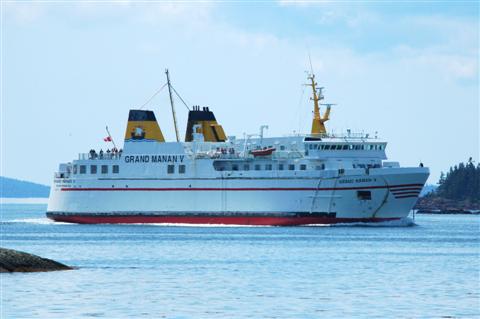
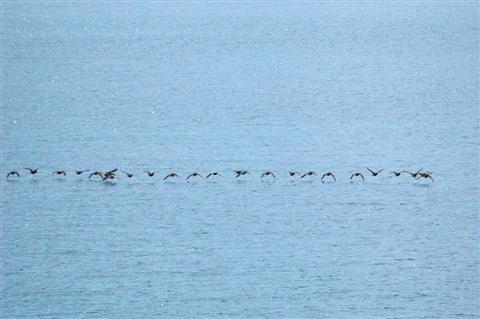
We got on board and headed straight for the outside deck to watch
for wildlife.
During the 2-hour crossing, we saw a few flocks of Common Eiders,
several Greater Shearwaters, and a few Harbour Porpoises and Grey
Seals.
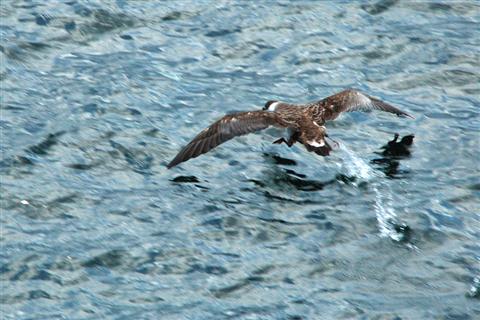
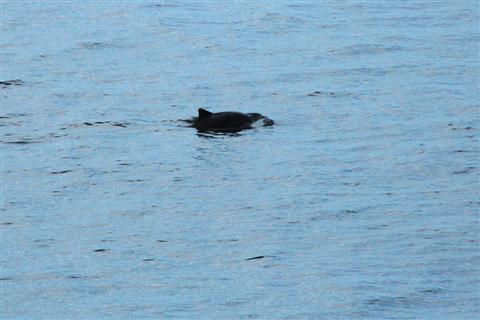
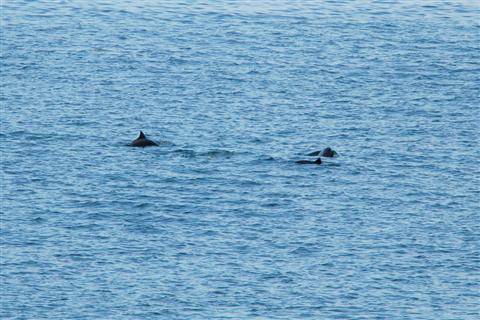
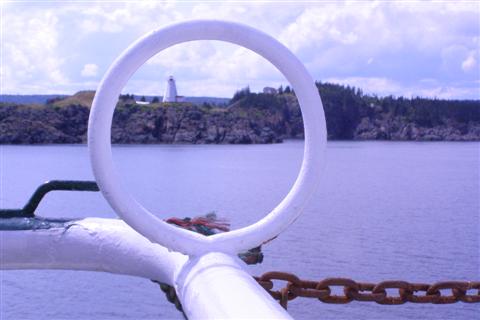
We landed on Grand Manan, and drove south towards the campground
at the Anchorage Park, stopping only to get a few groceries.
Along the way, we saw a birding group stopped at a gas station
with their guide, Ottawa’s own Bruce Di Labio.
We got a site at the park with no problem and were greeted by an
Alder Flycatcher. We set up our tent and tried out our new
barbecue, which worked very well.
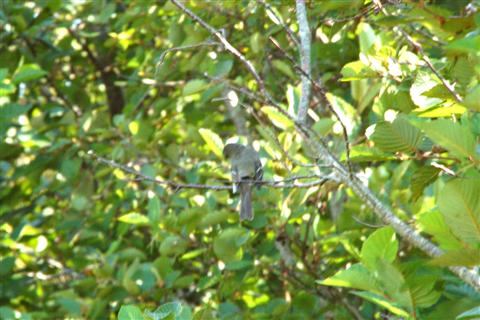
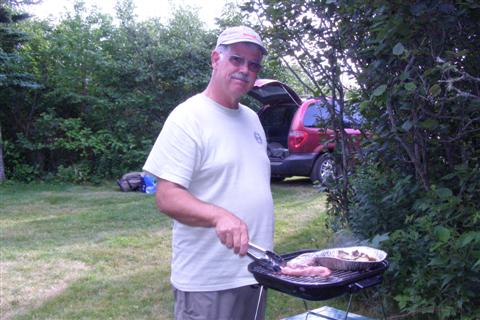
August 8
We had an early morning tour with SeaWatch
Tours to go to Machias Seal Island to see the Atlantic Puffins.
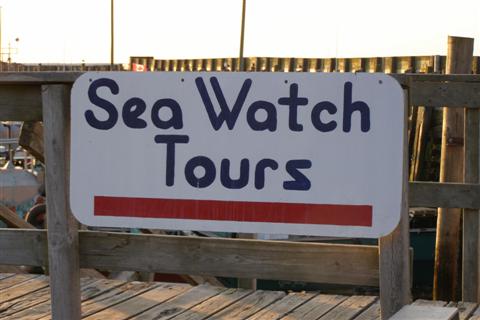
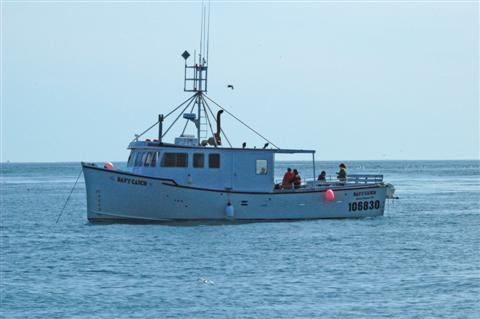
We had seen them last year in Witless Bay, NF,
but this was different. We were able to get out on shore and use
blinds specially constructed for the purpose of viewing the
Puffins. We were blesssed with a perfect day. Sometimes groups
cannot land due to fog or waves.
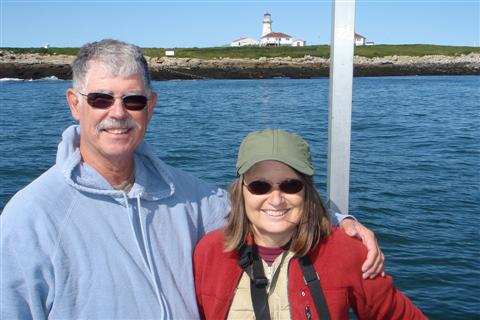
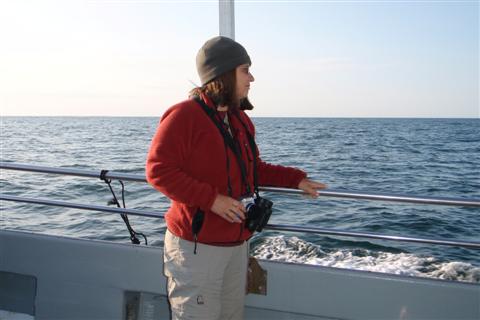
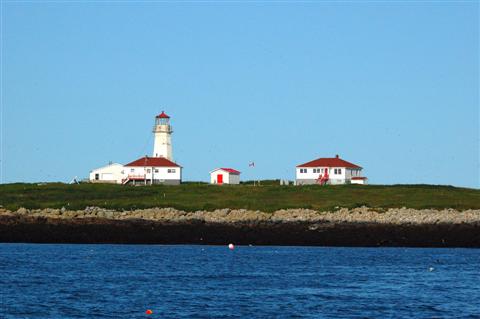
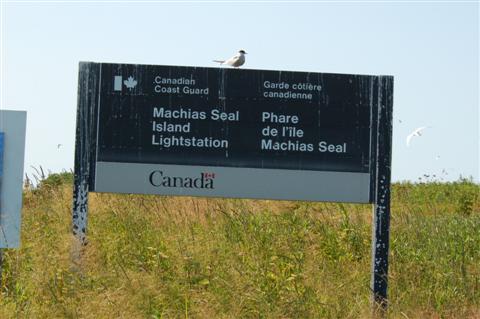
Captain Peter Wilcox of the "Days
Catch" made sure we all landed safely on the slippery rocks.
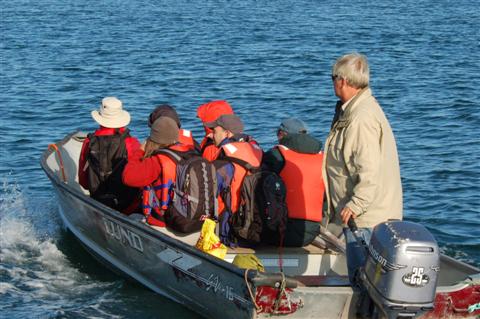
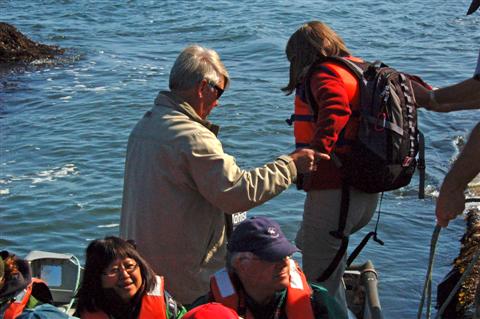
Puffins were everywhere. It hardly seemed
necessary to go into the blinds. Although Atlantic Puffins were
the stars, there were also Razorbill Auks and Arctic Terns.
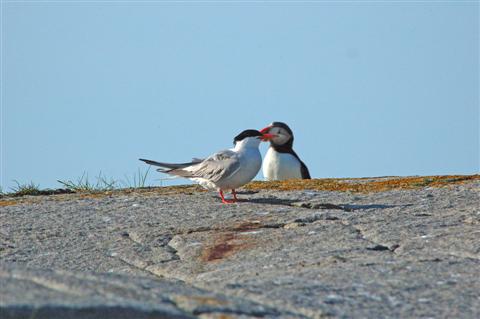
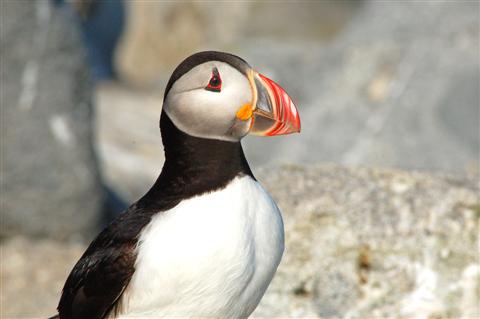
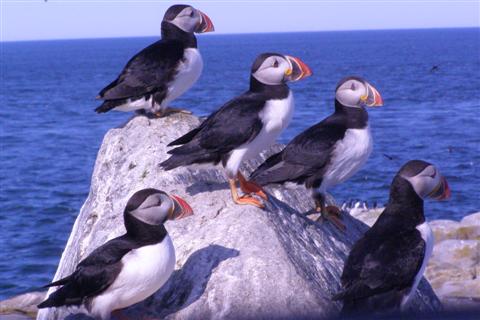
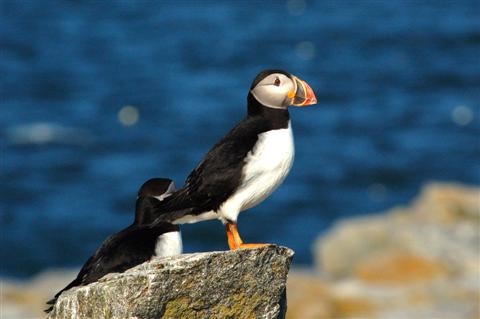
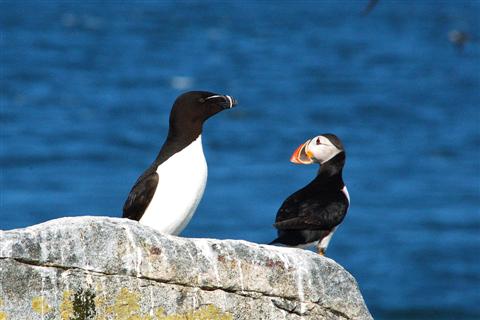
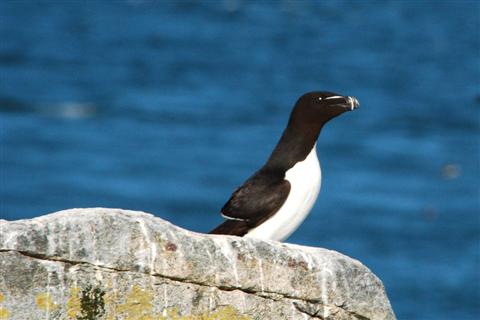
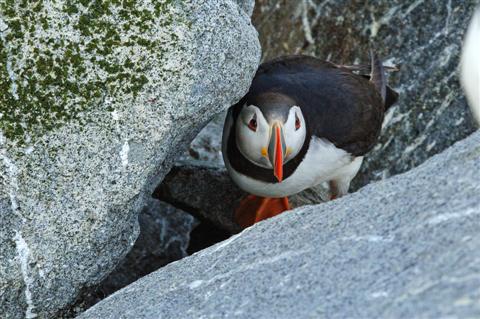
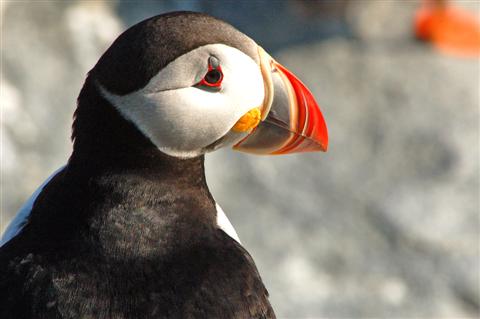
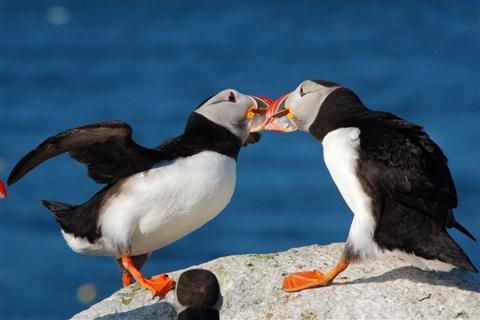
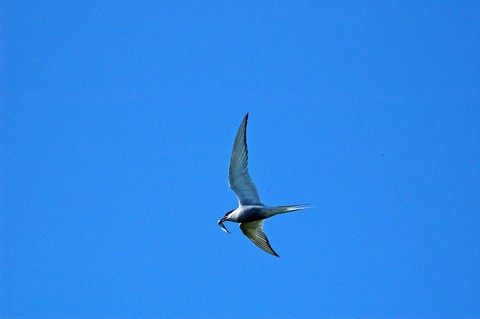
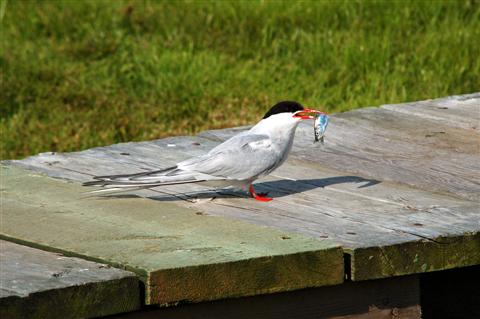
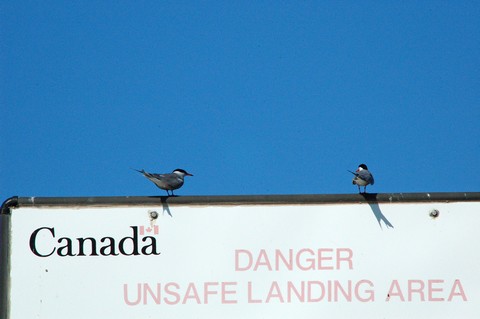
Before heading back to Seal Cove, we checked
out nearby North Rock to view the Grey Seal colony. We also had a
good view of a female Common Eider.
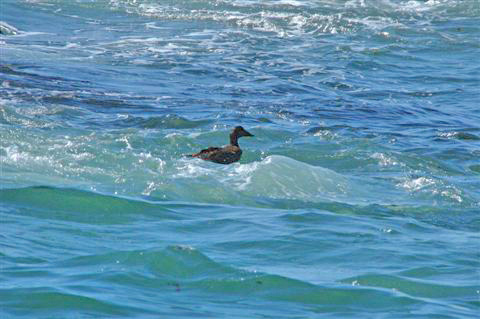
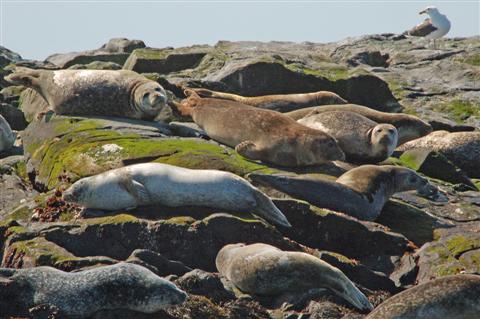
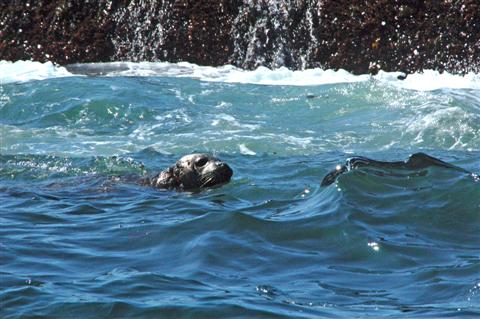
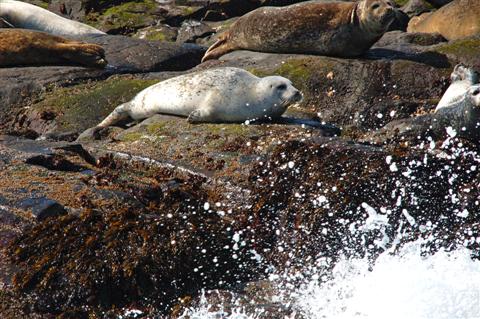
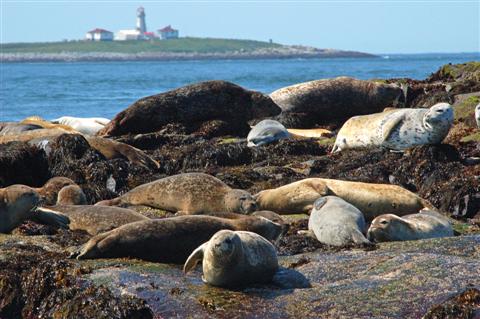
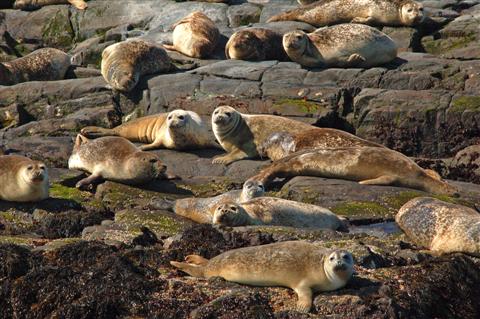
We got back to Seal Cove about 10:30 am, so
decided to drive down to Southwest Head Light station and hike
along the coast for a bit and back.
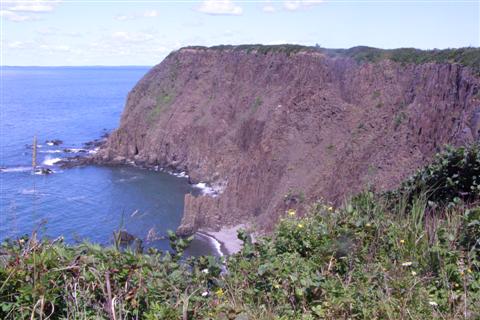
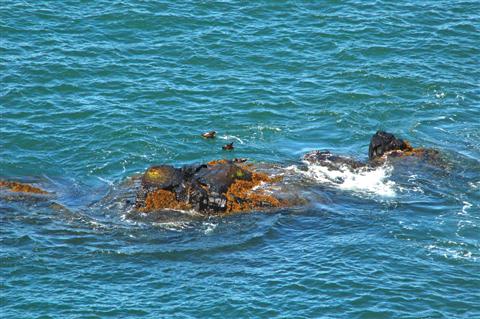
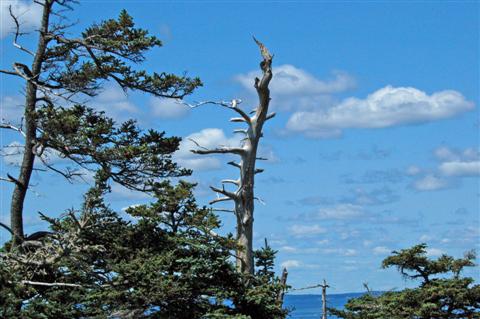
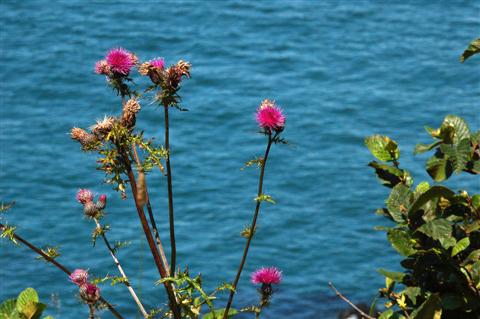
The coastline was extremely rugged, but the trail wasn’t too
bad, although wet in spots.
The shrubs were alive with sparrows and Common Yellowthroats.
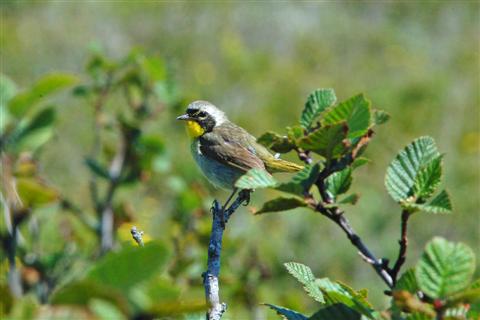
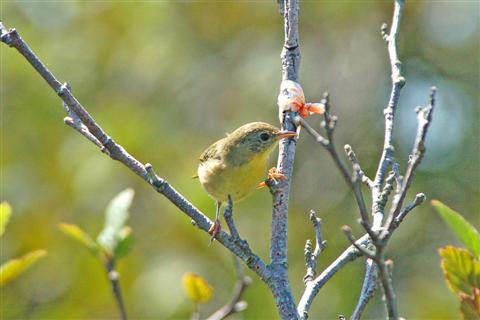
On the way back to Anchorage Park, we spotted some Common Eiders
close to shore along with a male Surf Scoter.
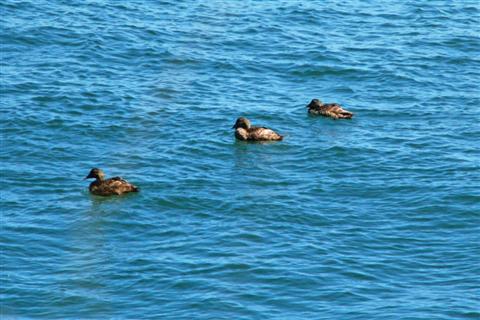
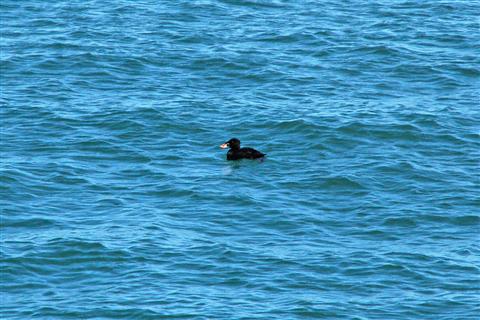
After a quick lunch, we explored the adjacent
Long Beach and the Long Pond migratory Bird Sanctuary. The ponds
had a few distant ducks, Eiders and American Widgeon.
There were several short trails through bogs, each teeming with
Savannah Sparrows, Song Sparrows and Common Yellowthroats.
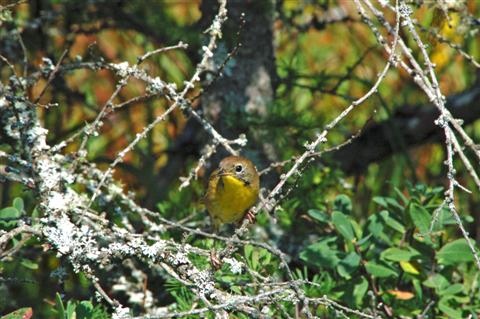
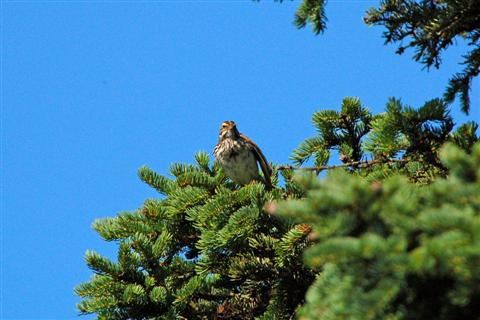
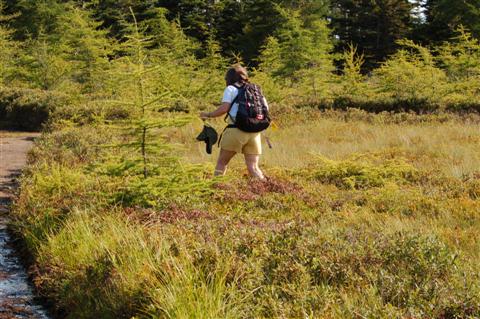
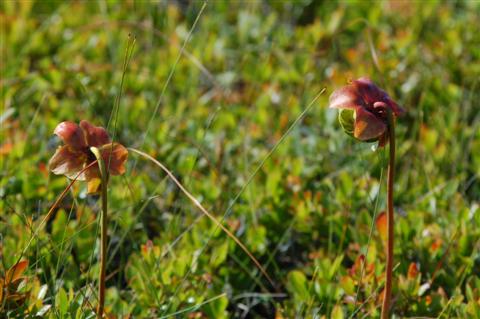
Back at our campsite, the shrubs provided lots of
interesting birds – waxwings, sparrows, robins &
catbirds.
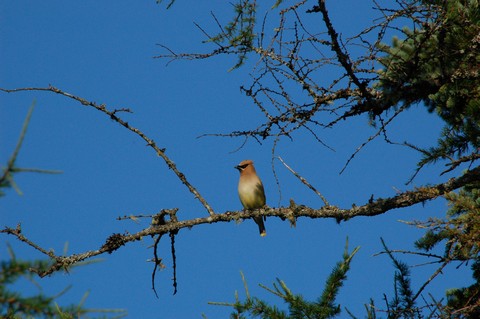
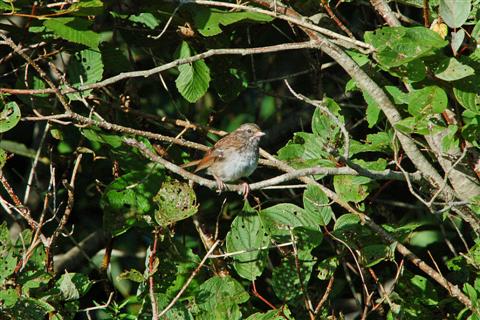
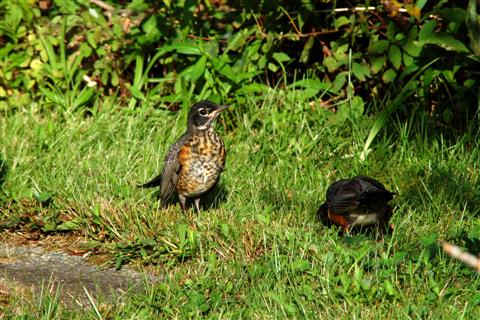
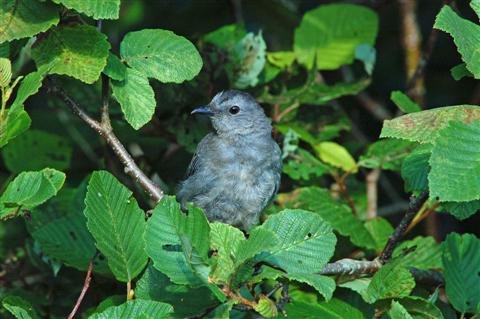
August 9
With continuing good weather, we decided to
spend the day on White Head Island. The ferry is tiny and we
found the schedule to be flexible. The white rock at the head of
the island is actually a result of blasting, so we were told.
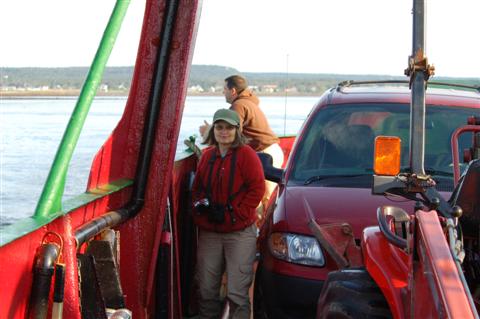
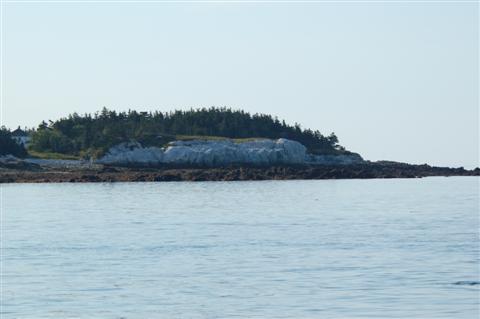
During the crossing, we saw many Double-crested Commorants, a
couple of Bald Eagles, and a flock of Common Eiders.
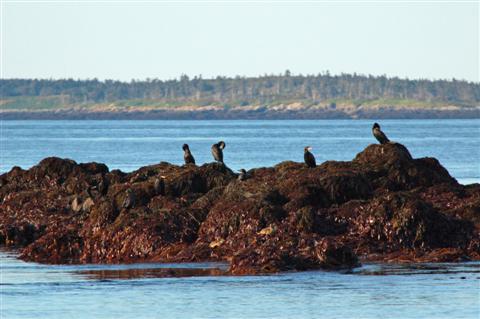
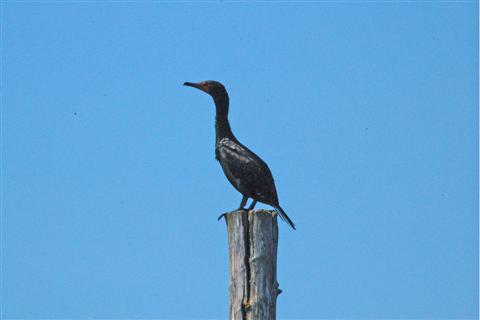
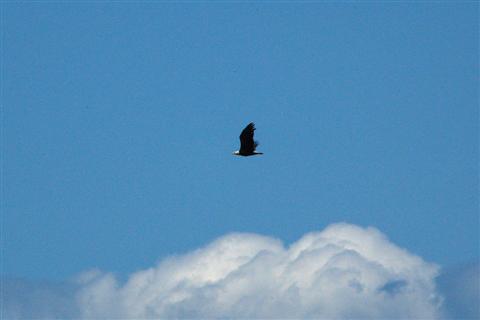
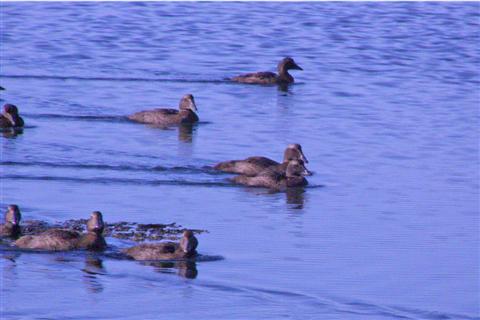
The island is small and without commercial establishment. We
drove to the far side and hiked to the Long Point Lighthouse. We
saw the usual assortment of sparrows and common warblers.
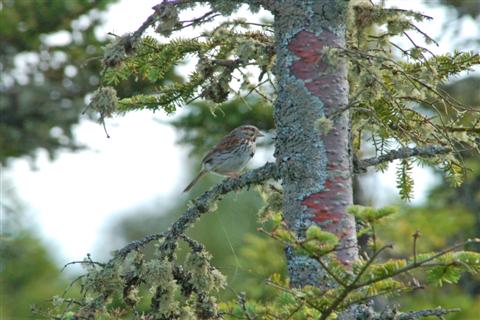
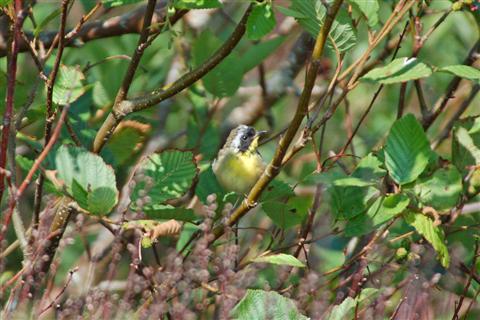
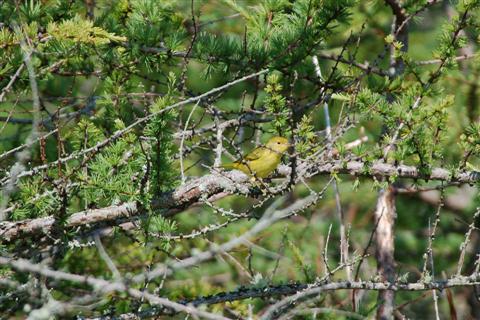
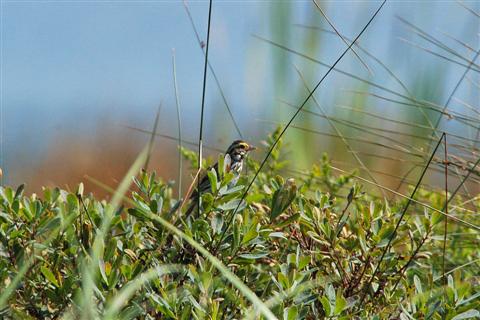
Then we drove to the other end of the island to check out the
“campground”. This consisted of a few decrepit tent
platforms. The beach was being used for drying dulse. We ate our
lunch and watched a small flock of Semi-palmated Plovers fly
past. As usual, there were sparrows and warblers flitting about.
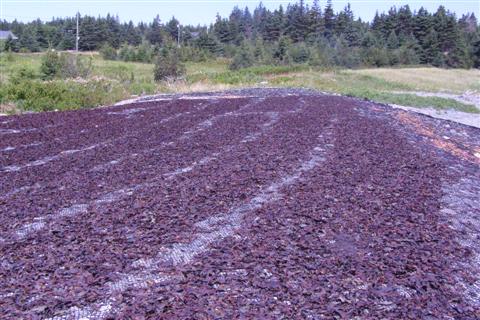
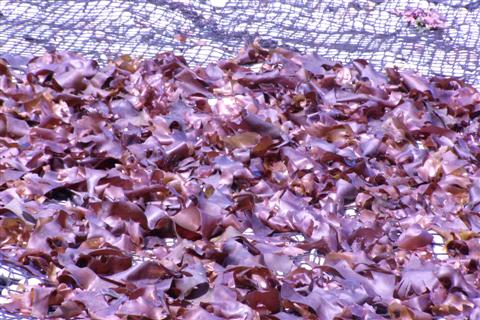
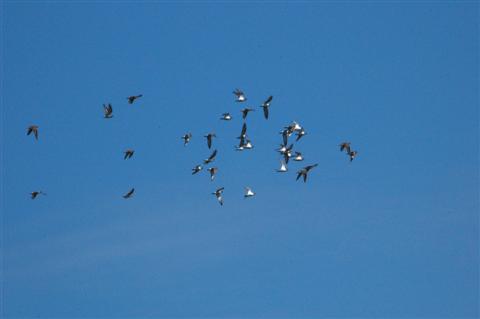
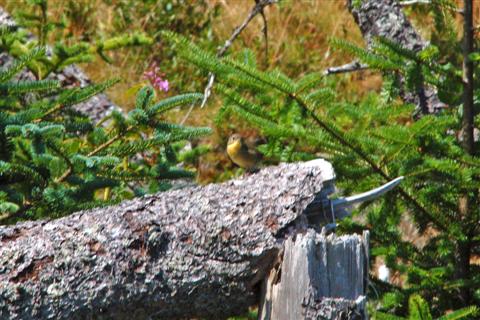
We headed back to get the ferry, only to find a long line of
cars, way more than the capacity of the ferry. However, most of
these were just holding a spot and not leaving right away, so we
did get on. Phew!
We decided to check out Castalia Marsh, which is known for
Nelson’s Sparrows. We had no luck, but had a sandpiper
fly-past and got good close-ups of a lone Semi-palmated Sandpiper
on the beach.
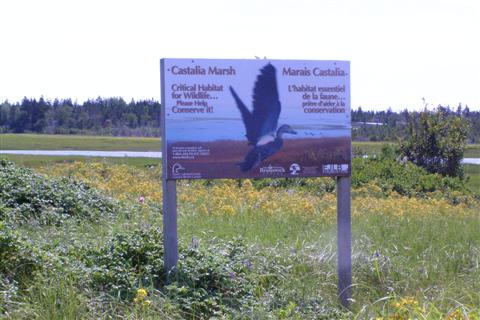
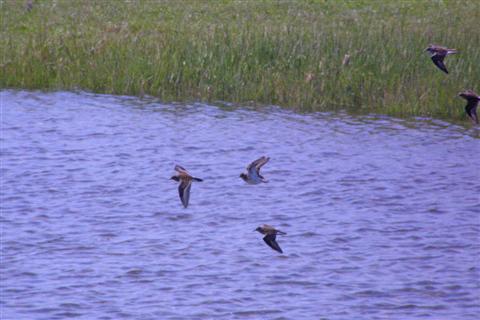
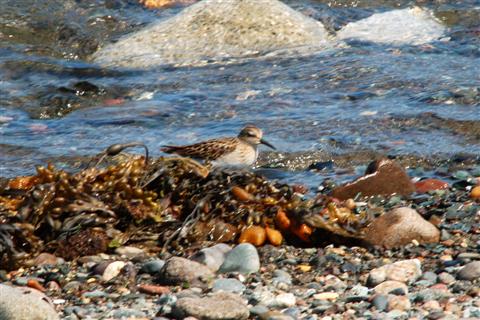
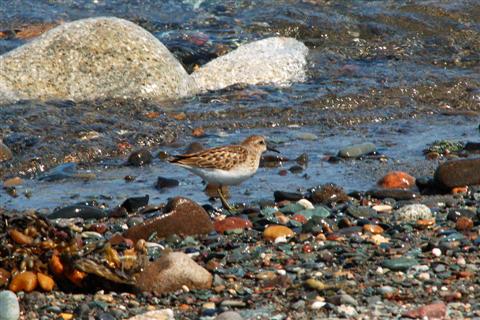
August 10
A pair of American Redstarts entertained us at our campsite.
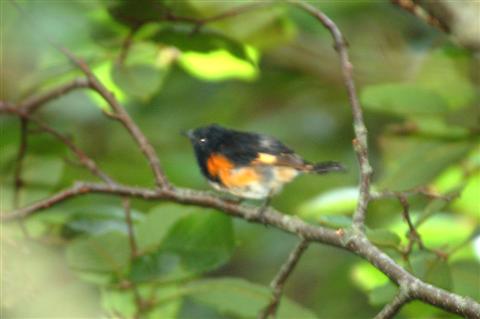
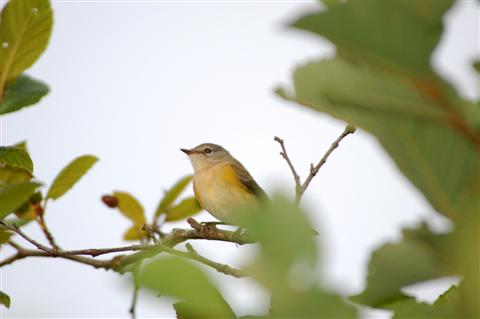
Today we booked a whale watching tour with Sea Watch tours, but
the fog was threatening.
We drove up to the Whistle at Long Eddy Point to do some birding
while awaiting word on the whale tour. We had good luck –
White-throated Sparrow, Brown Creeper, Golden-crowned Kinglet,
Black and White Warbler Blackpoll Warbler, and American
Goldfinch. We even spotted a couple of the Ring-necked Pheasants.
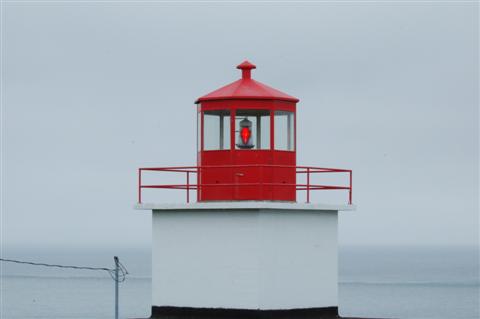
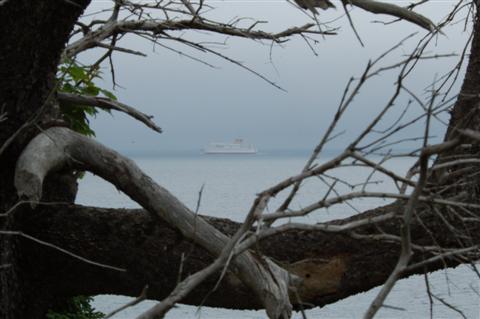
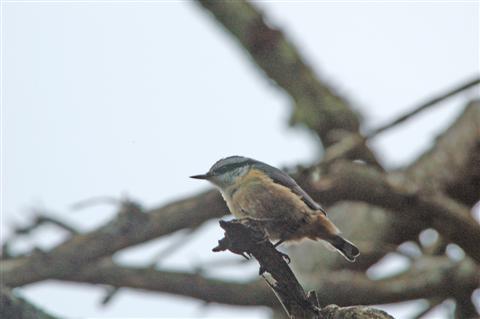
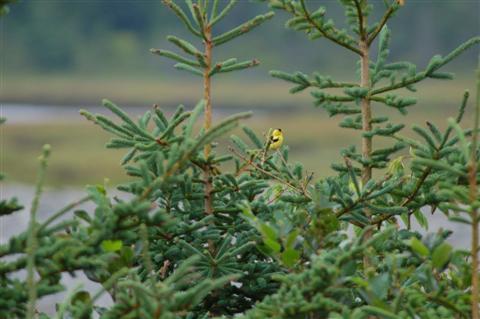
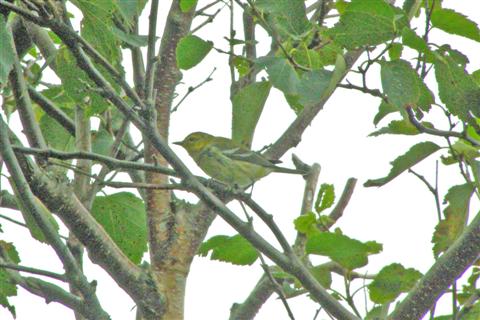
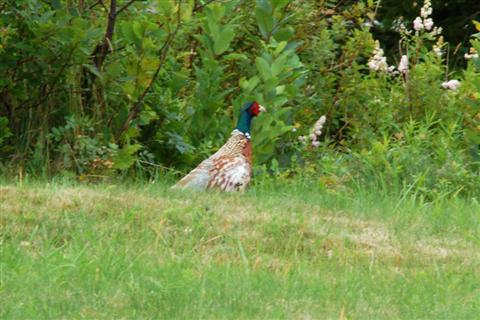
We called Sea Watch Tours and were told that, although conditions
were not good, we would try to see if they were better off shore.
Alas, after an hour, the captain declared it a loss, and returned
to port. As per his guarantee, we did not have to pay for that
trip. We did see a Common Loon in the fog.
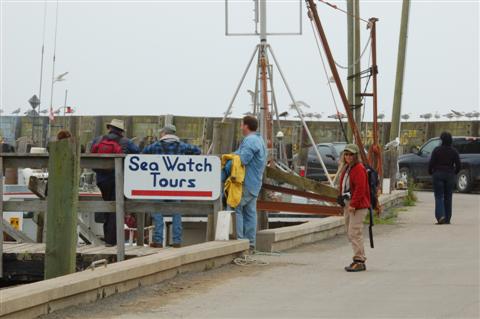
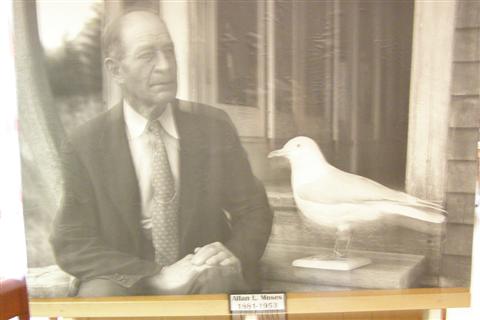
We lost two hours, so went to the store for ice cream to drown
our sorrows (ha!) The bushes across the street where we had
parked were crawling with mainly Yellow Warblers. We also went
into the museum to see Allan Moses's large collection of stuffed
birds.
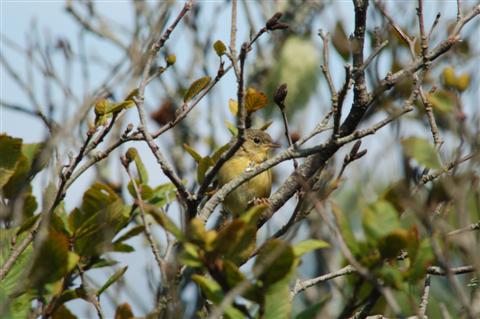
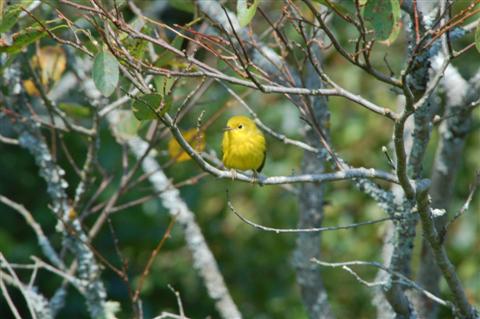
We drove to Dark Harbour and looked around the beach. There we
saw a White-throated Sparrow and a Cedar Waxwing.
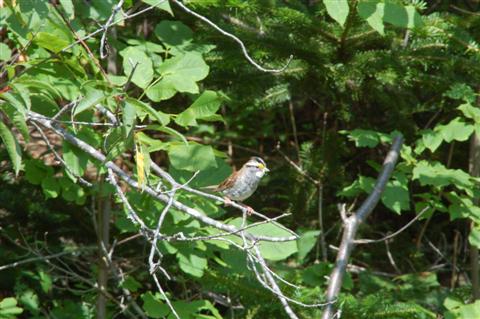
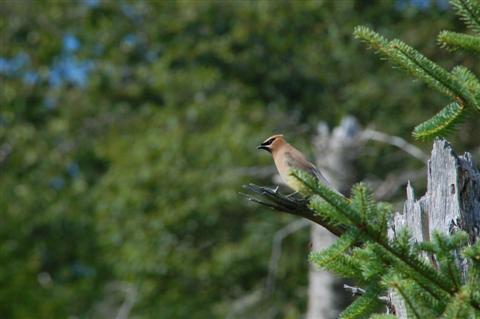
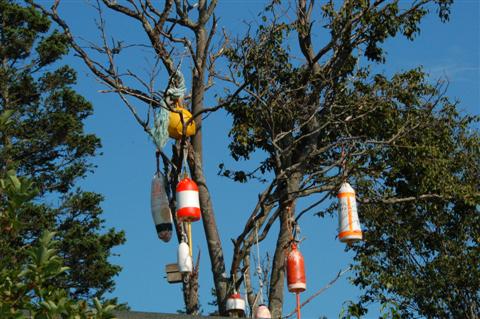
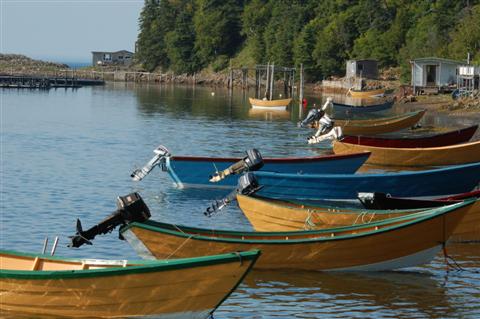
August 11
This would be our last chance for whale watching, and the weather
was looking much like the previous day.
We drove to Swallowtail Lighthouse to bird while awaiting news on
the whale watching. It was a very scenic area with steep wooden
stairs over a gorge. We spotted a Black Guillemot and an Osprey
from the stairs.
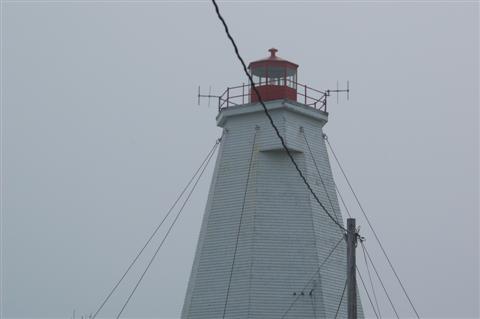
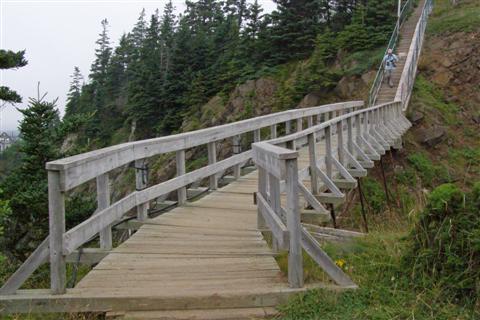
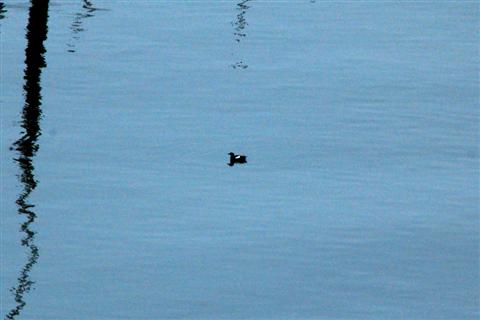
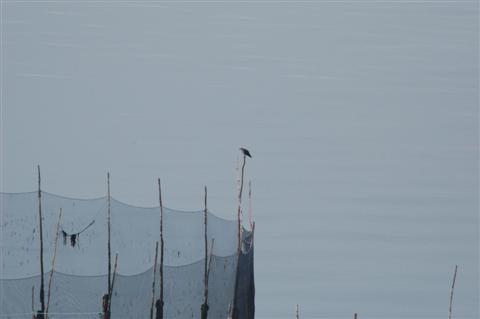
We booked our passage on the 9 am ferry and a
room at Shorecrest Lodge for the night.
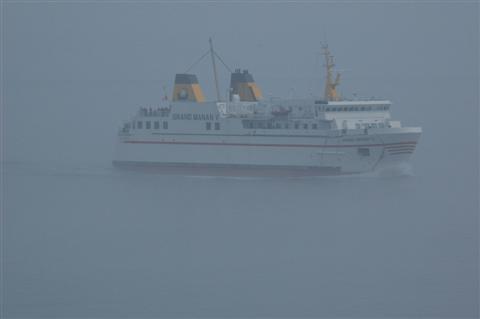
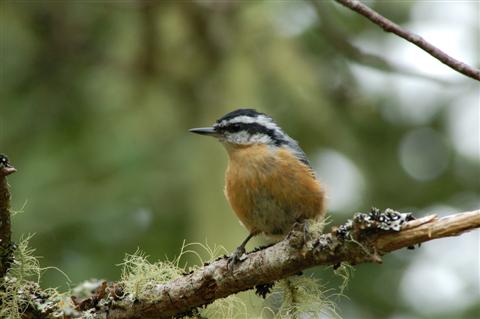
We thought we had time to hike to Hole in the Wall, but could not
find the correct trail. Nevertheless, we had an enjoyable hike in
the woods seeing many common species.
A phone call to Sea Watch informed us the tour was on, so we
hurried on down to Seal Cove. The visibility was not great, in
fact similar to the day before. But this time, things improved as
we got further out from shore.
We saw many Greater Shearwaters and fewer Sooty Shearwaters. And
with the help of Bruce Di Labio, who was on board with his group,
we saw some Wilson’s Storm-Petrels, a Manx Shearwater and a
Pomarine Jaeger.
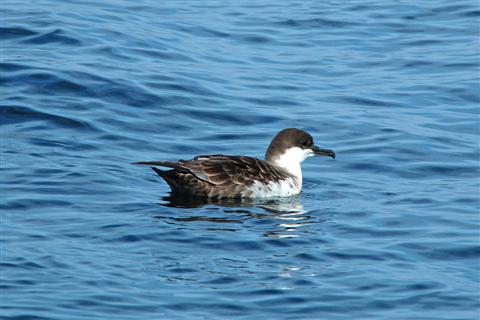
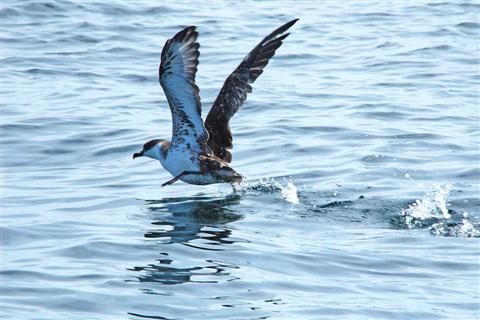
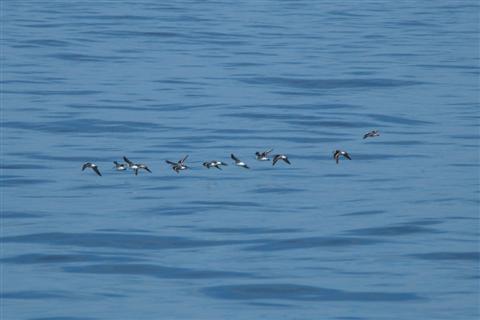
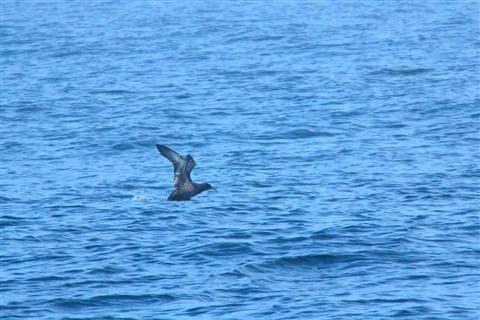
And we saw whales! Several whales! They were all Humpbacked
Whales except for one Finback Whale in the distance. It was an
amazing spectacle. There were two breaches, but I just got the
splash from one. A couple of the Humpbacks rolled on their sides
and extended their pectoral fins in the air.
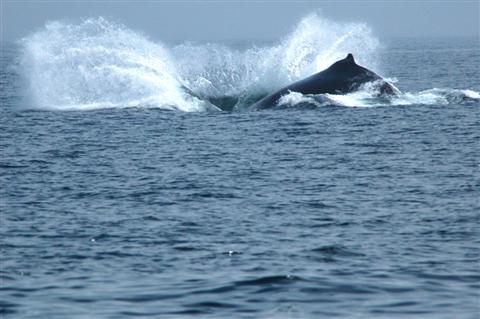
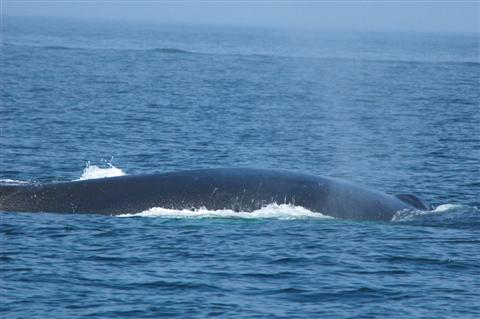
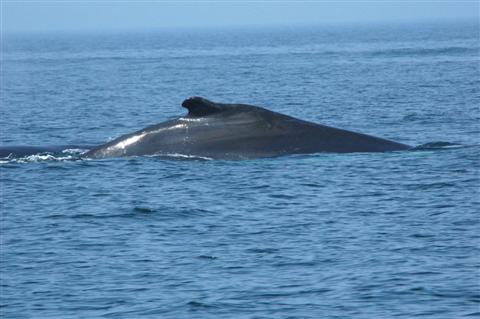
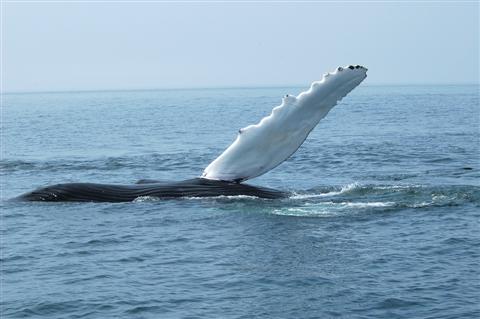
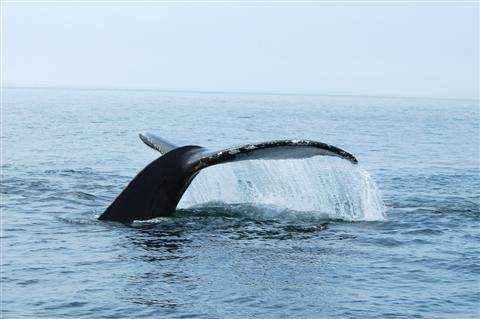
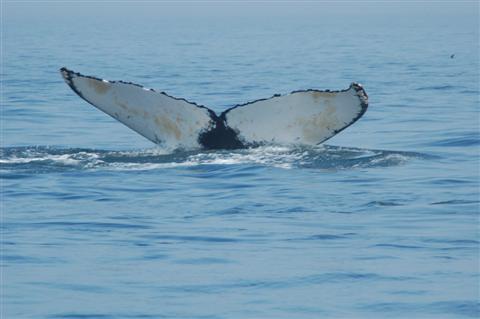
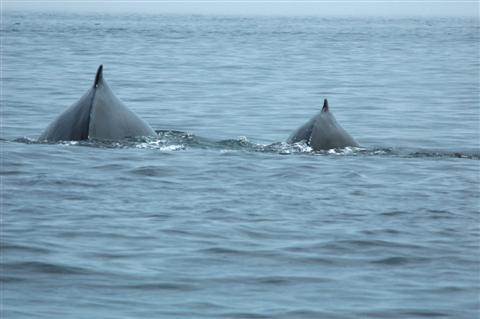
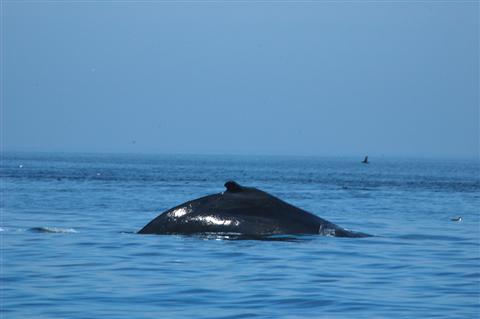
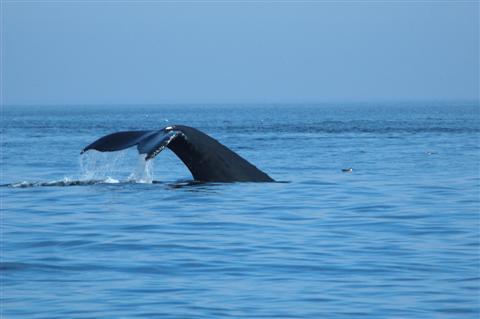
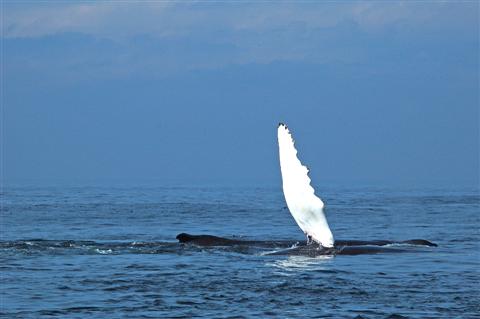
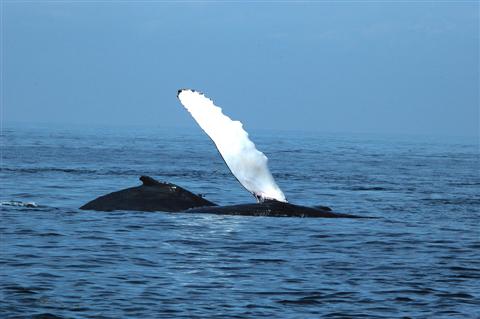
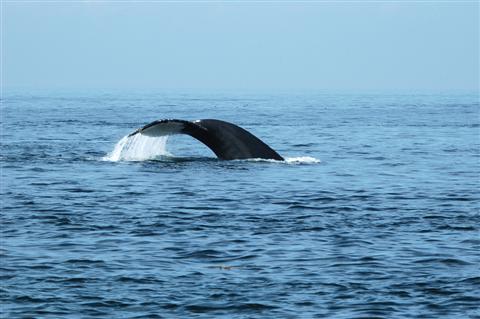
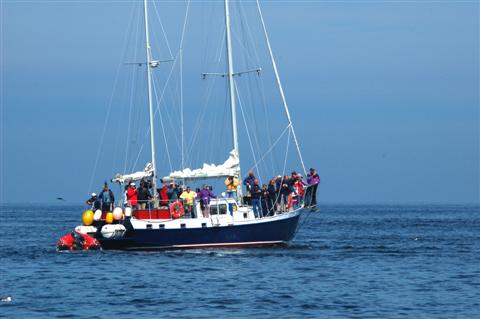
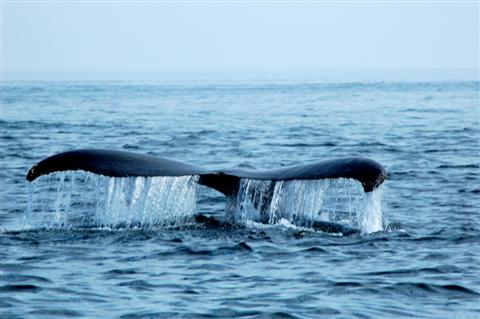
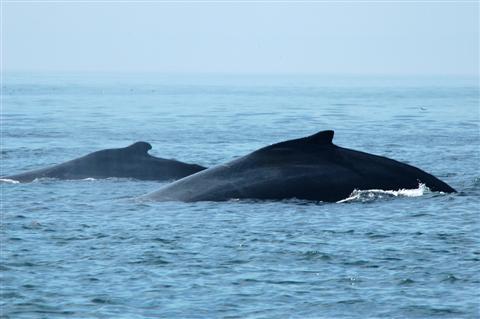
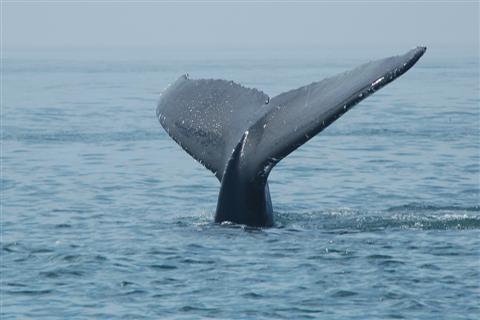
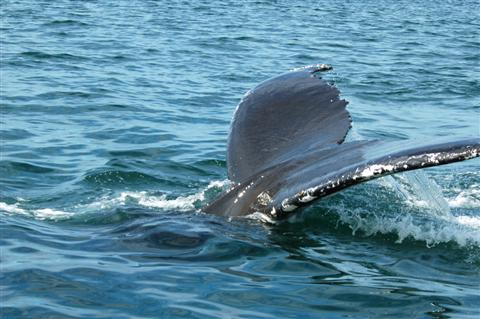
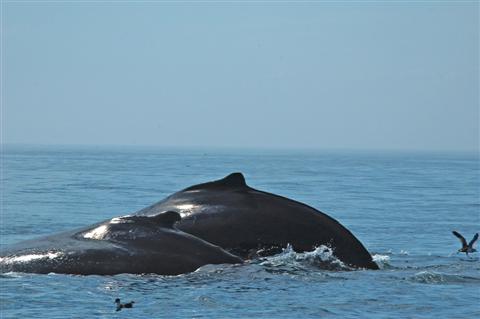
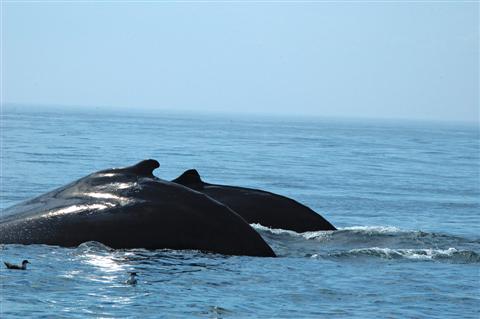
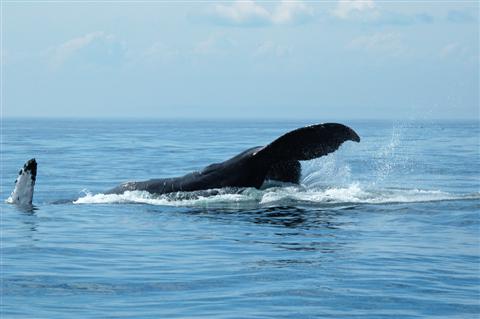
We saw groups of Red-necked Phalaropes, but no Red Phalaropes
unfortunately.
Finally we saw one Northern Gannet.
Bruce said they got a couple of Nelson’s Sparrows and a
Snowy Egret at Castalia Marsh, so we headed over there when the
whale watching tour was over. We saw the Egret right away, but
only Savannah Sparrows.
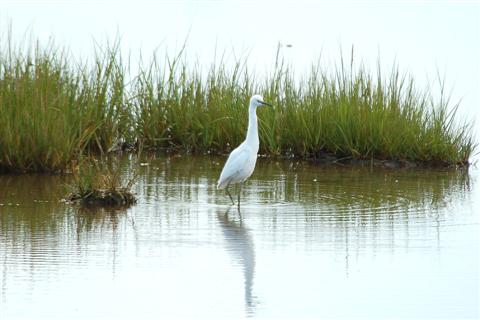
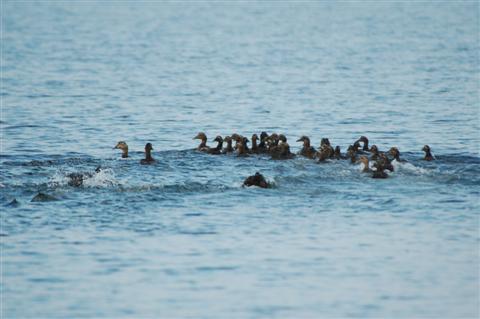
August 12
We had a pleasant night at Shorecrest Lodge and a so-so breakfast
there in the morning. The ferry was just across the street and we
got in line. We were glad to have booked, because the small ferry
takes relatively few cars and, being among the first to board, we
got to drive on and turn around. Most later vehicles had to back
down the ramp and on.
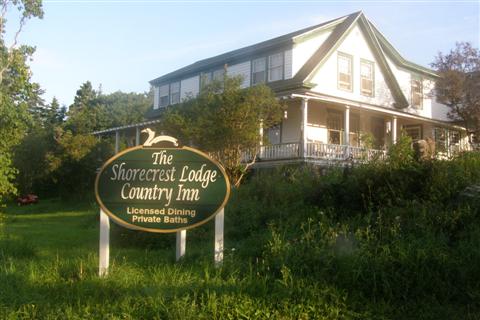
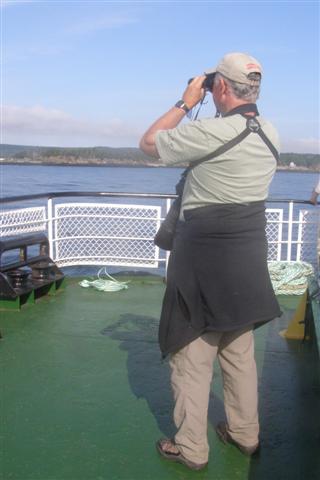
We saw a helicopter removing bagged contaminated soil from around
the Swallowtail Lighthouse. We had guessed about those bags on
our visit the day before.
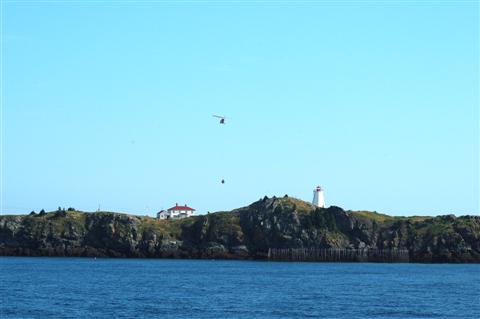
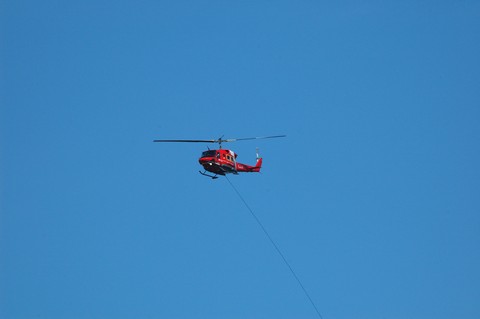
Bruce Di Labio pointed out a Great Cormorant in flight – a
lifer! The crossing to Blacks Harbour was uneventful, and we saw
nothing else new.
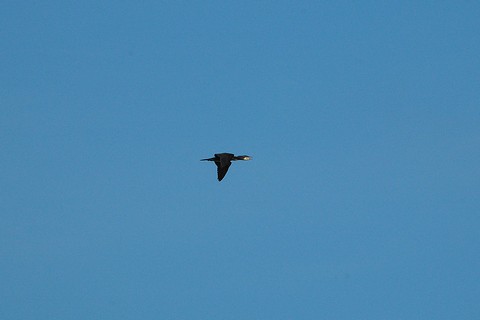
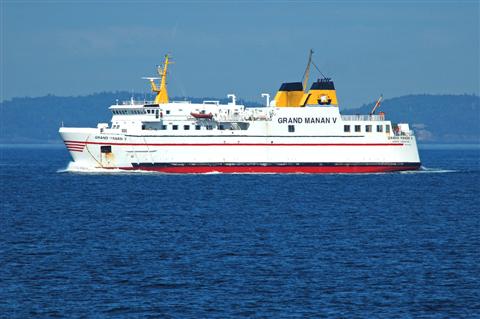
We stopped for a few groceries and then headed straight for the
Irving Nature Park in Saint John. We got separated here and did
separate birding. Highlights were warblers, including American
Redstart and Black and White, a close encounter with a Bald
Eagle, and two Red Foxes.
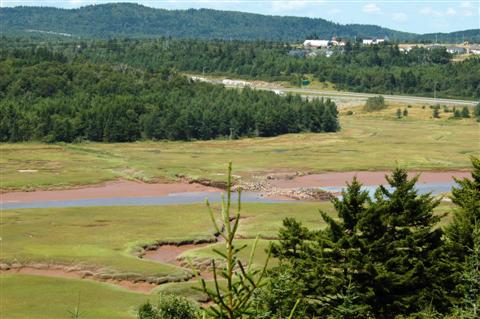
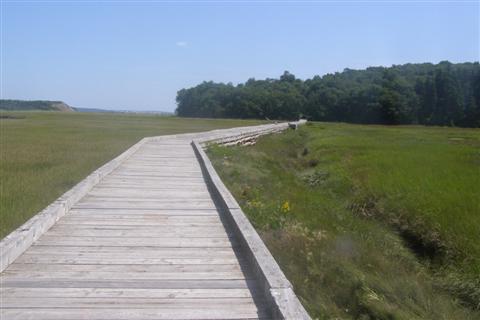
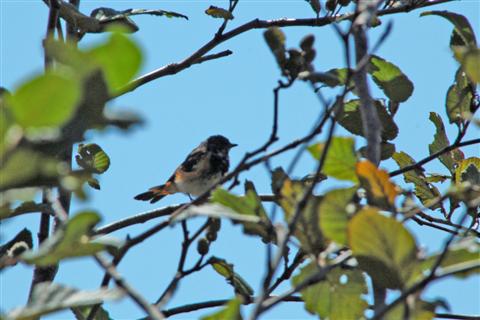
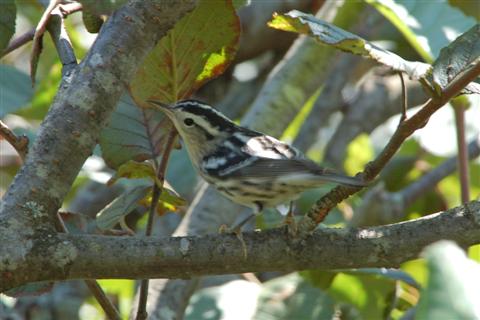
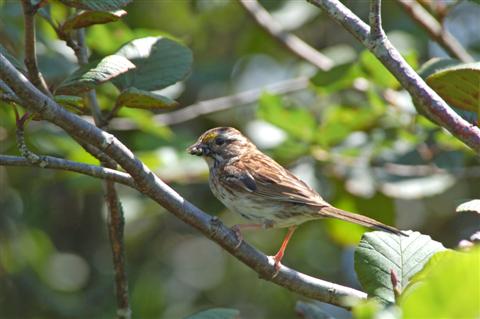
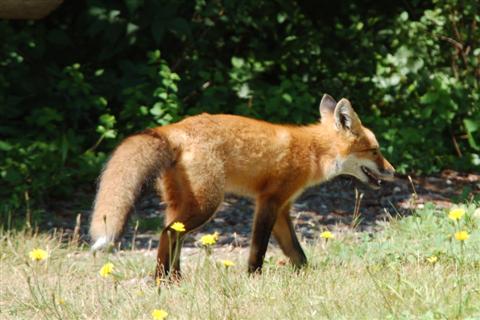
On the road again, we made it as far as
Oromocto, where we found a pleasant camping spot at
Sunbury-Oromocto Campground. Several people told us about the
eagles and other birds that came by, but we didn’t see much.
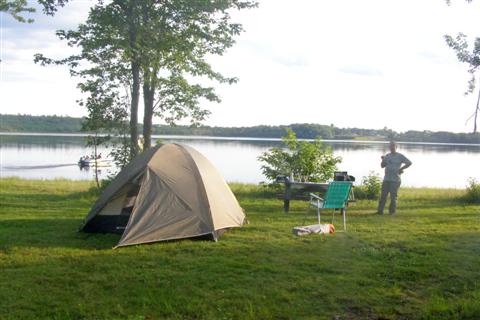
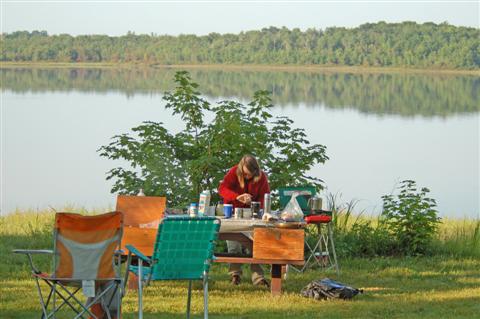
August 13
We packed up quickly and headed for Métis-sur-Mer, Québec. We
were going to drop in on our friends Bill & Cathy from
Chelsea, who have a summer home there.
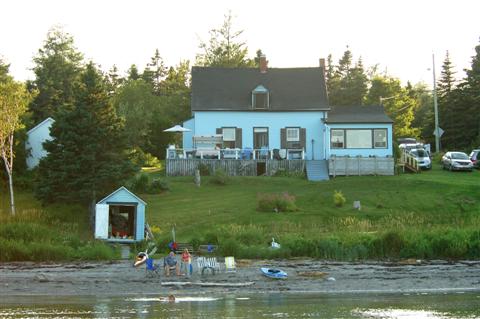
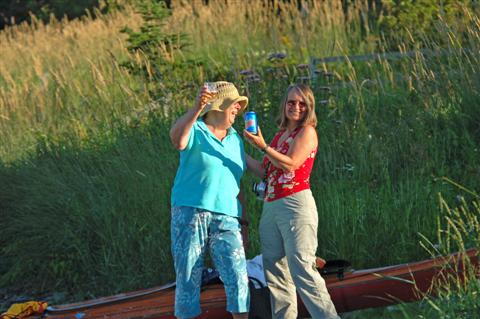
Their daughters Kim and Mandy were also there, as were
Mandy’s two children.
We had a pleasant afternoon visiting. We went out in Mandy’s
boat and got close up to some seals and Common Eiders.
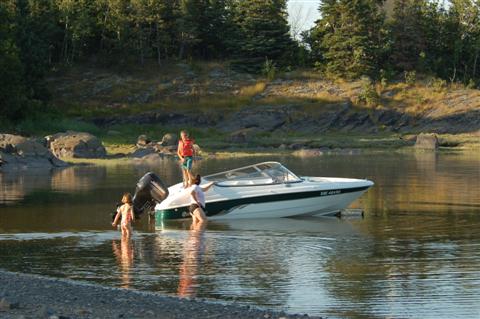
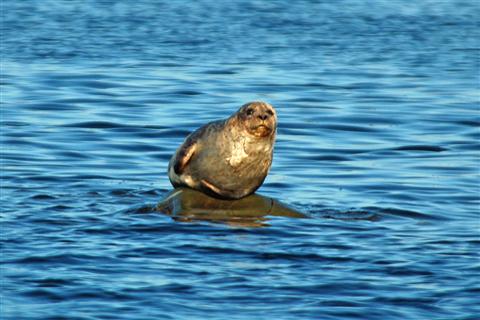
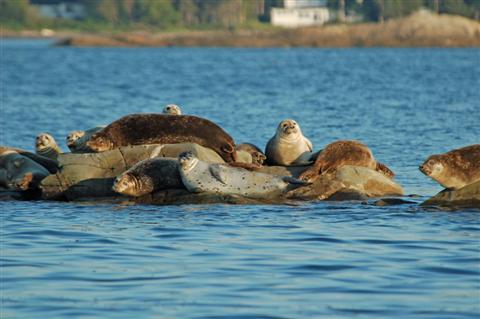
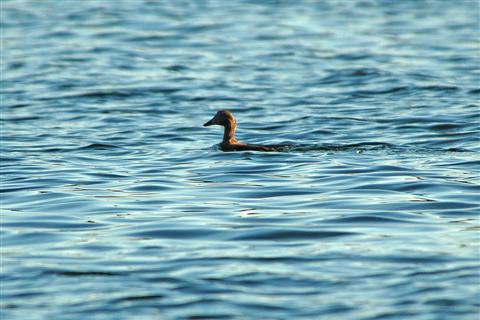
We were going to pitch our tent, but they
convinced us to sleep in one of their bedrooms.
August 14
Bill P. made jumbo blueberry pancakes for breakfast. Yum.
We decided to do a morning hike by the shore before leaving for
home. While that was getting organized, we checked out the birds
right in front of their place. A Hooded Merganser and two Common
Goldeneyes were parading up and down the waterfront.
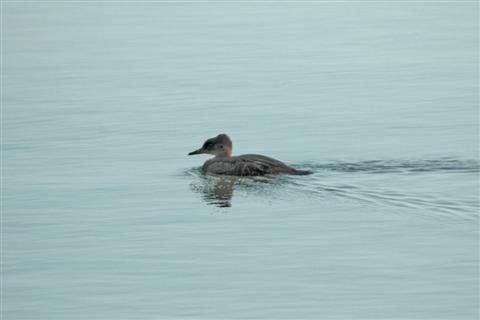
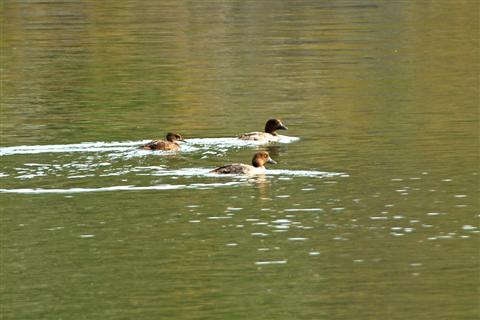
We hiked down the road to the lighthouse. In the scrub, there
were several warblers, including a Cape May and many
Yellow-rumps.
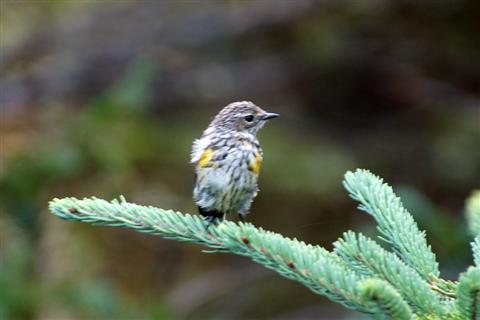
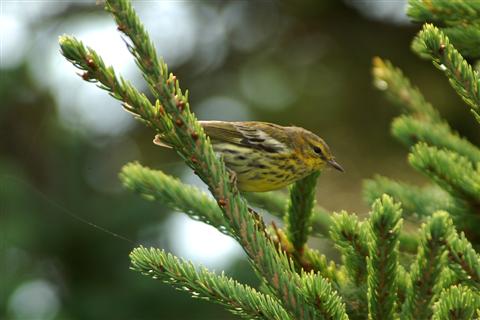
In front on the lighthouse, there were a couple of male Common
Eiders sleeping on the rocks, and a female patrolling the shore.
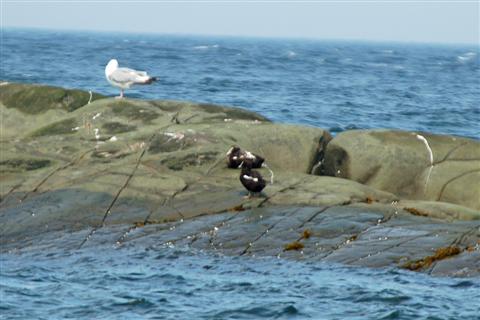
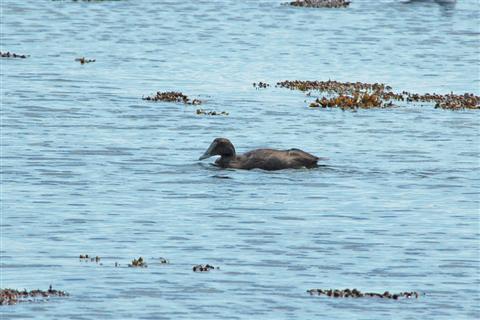
On the road back to the cottage, there was a small pond, where we
saw a Merlin swoop in to check things out.
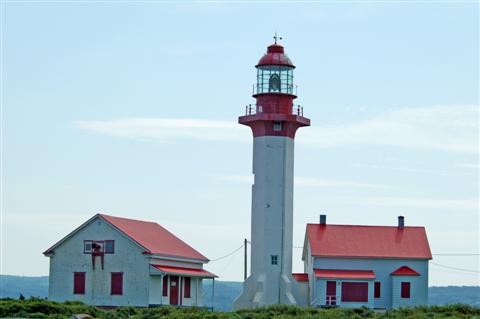
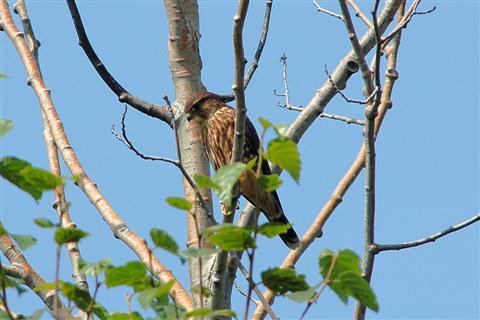
We reluctantly took our leave, and headed west intending to make
a couple of stops along the way. Our first stop was at
L’Isle-Verte, where we jumped a Northern Harrier, which gave
us good photo opportunities.
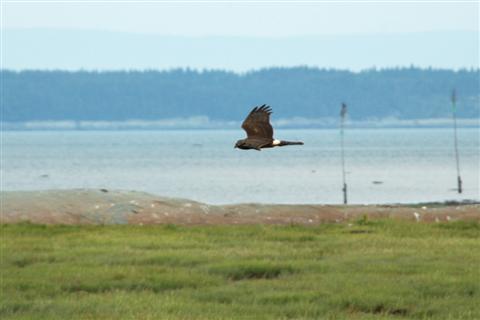
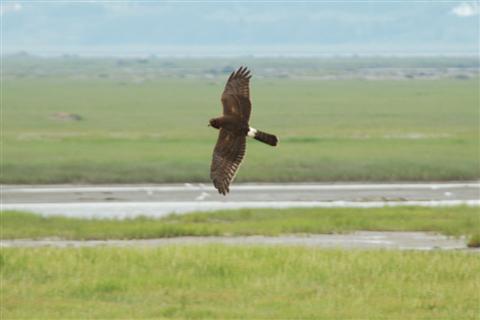
Our second stop was at Cacouna, which had been recommended by
Bruce Di Labio.
This was an area where one could spend a lot more time. There was
a sign about Nelson’s Sparrows, so we looked carefully for
one, but only found Savannahs. In the water there were many
ducks, mostly Blacks.
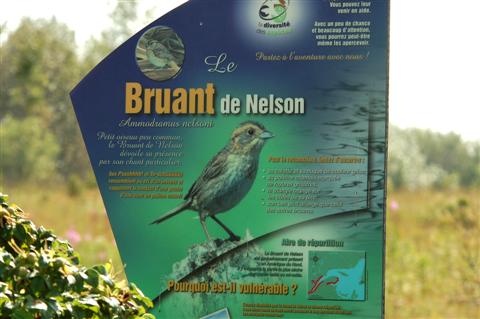
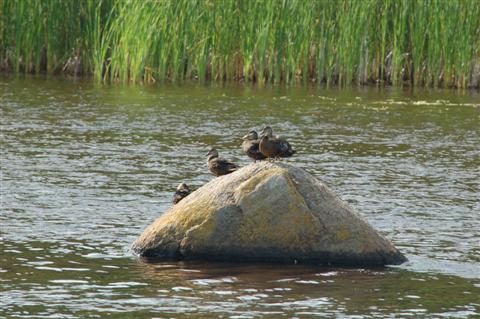
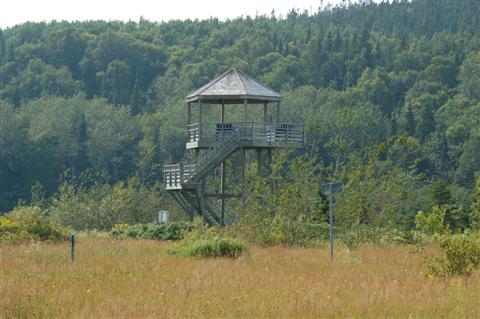
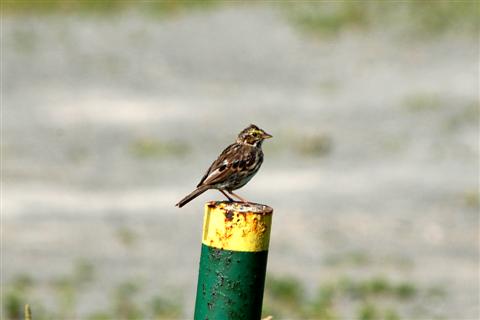
We were still along way from home, but we decided to push right
on all the way. It was time to be there.
To see Part 1, Fundy Shore, click here.























